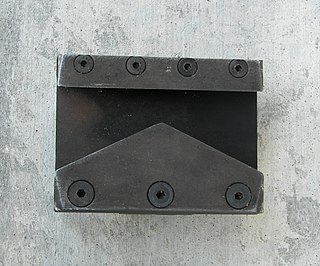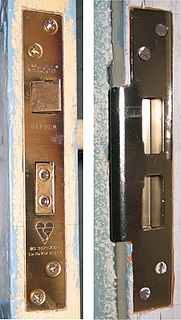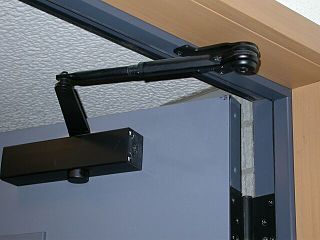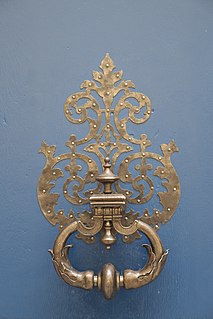
A knife is a tool or weapon with a cutting edge or blade, usually attached to a handle or hilt. One of the earliest tools used by humanity, knives appeared at least 2.5 million years ago, as evidenced by the Oldowan tools. Originally made of wood, bone, and stone, over the centuries, in step with improvements in both metallurgy and manufacturing, knife blades have been made from copper, bronze, iron, steel, ceramic, and titanium. Most modern knives have either fixed or folding blades; blade patterns and styles vary by maker and country of origin.

Wood carving is a form of woodworking by means of a cutting tool (knife) in one hand or a chisel by two hands or with one hand on a chisel and one hand on a mallet, resulting in a wooden figure or figurine, or in the sculptural ornamentation of a wooden object. The phrase may also refer to the finished product, from individual sculptures to hand-worked mouldings composing part of a tracery.

A Halligan bar is a forcible entry tool used by firefighters.

The K-tool is a tool used by many fire departments for forcible entry. It is used in conjunction with a Halligan bar and a flat-headed axe or maul to remove a cylinder lock. It consists of a steel block roughly 3 inches by 3 inches by 1 inch thick with a K-shaped notch on one side, having sharp edges that grip the cylinder, and a U-shaped flange on the other side. The notch is slipped over the lock cylinder, then forced down by striking with the flat side of the axe or maul. The halligan is then inserted into the flange and used to pry the K-tool off the door, thereby pulling the entire key cylinder out. The bolt is then retracted from the inside of the cylinder hole using a turning tool, such as a screwdriver.

A butterfly knife, also known as a Balisong, fan knife or Batangas knife, is a type of folding pocketknife that originated in the Philippines. Its distinct features are two handles counter-rotating around the tang such that, when closed, the blade is concealed within grooves in the handles. A latch holds the handles together, typically mounted on the one facing the cutting edge.

A mortise lock is a lock that requires a pocket—the mortise—to be cut into the edge of the door or piece of furniture into which the lock is to be fitted. In most parts of the world, mortise locks are found on older buildings constructed before the advent of bored cylindrical locks, but they have recently become more common in commercial and upmarket residential construction in the United States. The design is widely used in domestic properties of all vintages in Europe.

Door furniture or door hardware refers to any of the items that are attached to a door or a drawer to enhance its functionality or appearance.

A door handle or doorknob is a handle used to open or close a door. Door handles can be found on all types of doors including exterior doors of residential and commercial buildings, internal doors, cupboard doors and vehicle doors. There are many designs of door handle, depending on the appropriate use. A large number of handles, particularly for commercial and residential doors, incorporate latching or locking mechanisms or are manufactured to fit to standardised door locking or latching mechanisms.

Forcible entry is "the unlawful taking of possession of real property by force or threats of force or unlawful entry into or onto another's property, especially when accompanied by force". The term is also sometimes used for entry by military, police, or emergency personnel, also called breaching. For the fire service, forcible entry is defined by the International Fire Service Training Association (IFSTA) as:
This is a glossary of firefighting equipment.

A latch or catch is a type of mechanical fastener that joins two objects or surfaces while allowing for their regular separation. A latch typically engages another piece of hardware on the other mounting surface. Depending upon the type and design of the latch, this engaged bit of hardware may be known as a keeper or strike.
The pig is a specialty firefighting tool used mainly for roof ventilation, forcible entry and wall breaching. Invented by a member of the Austin Fire Department, the tool combines the butt-end of a flat head axe on one side and a pick on the other. The pig can be married with a Halligan to create a forcible entry system as an alternative to the classic axe and Halligan combination.

The term door security or door security gate may refer to any of a range of measures used to strengthen doors against door breaching, ram-raiding and lock picking, and prevent crimes such as burglary and home invasions. Door security is used in commercial and government buildings, as well as in residential settings.

Door breaching is a process used by military, police, or emergency services to force open closed or locked doors. A wide range of methods are available depending on the door's opening direction, construction materials, etc., and one or more of these methods may be used in any given situation. In the United States, residential doors typically open inward while commercial building doors usually open outward. Some breaching methods require specialized equipment and can be categorized as one of the following: mechanical breaching, ballistic breaching, hydraulic breaching, explosive breaching, or thermal breaching.

The Kelly tool is a tool used in fire and rescue service for forcible entry and other prying and striking tasks. The predecessor of the Halligan bar, it has largely been superseded by the latter, but still sees some use.

A linoleum knife is a small knife that has a short, stiff blade with a curved point and a handle and is used to cut linoleum or other sheet materials such as wood panelling and veneer and sheet mica.

A lockset is the hardware and components that make up the locking or latching mechanism that can usually be found on a door or other hinged object but can also include sliding doors and dividers. The components of a lockset can include the door handles, latch bolt, dead bolt, face plate, strike plate, escutcheon, thumbturn, push button, turn button, and other trim. The lockset and associated hardware typically defines a door's function and how a user could access the two adjacent spaces defined by the opening associated with the lockset.
A night latch is lock that is fitted on the surface of a door; it is operated from the exterior side of the door by a key and from the interior side of the door by a knob.
The claw tool is a forcible entry tool used by firefighters, made of steel, that has a hook on one end and a forked end on the other. The tool was a major component in the Fire Department of New York during the early 20th century. Over the last fifty years, the claw tool has lost prominence due to the advent of newer and more efficient forcible entry tools.
An officer’s tool is a forcible entry device used by firefighters and other first responders. Officer’s tools are designed to completely remove cylindrical locks from doors without causing major structural damage, allowing for direct access to the internal locking mechanism.















